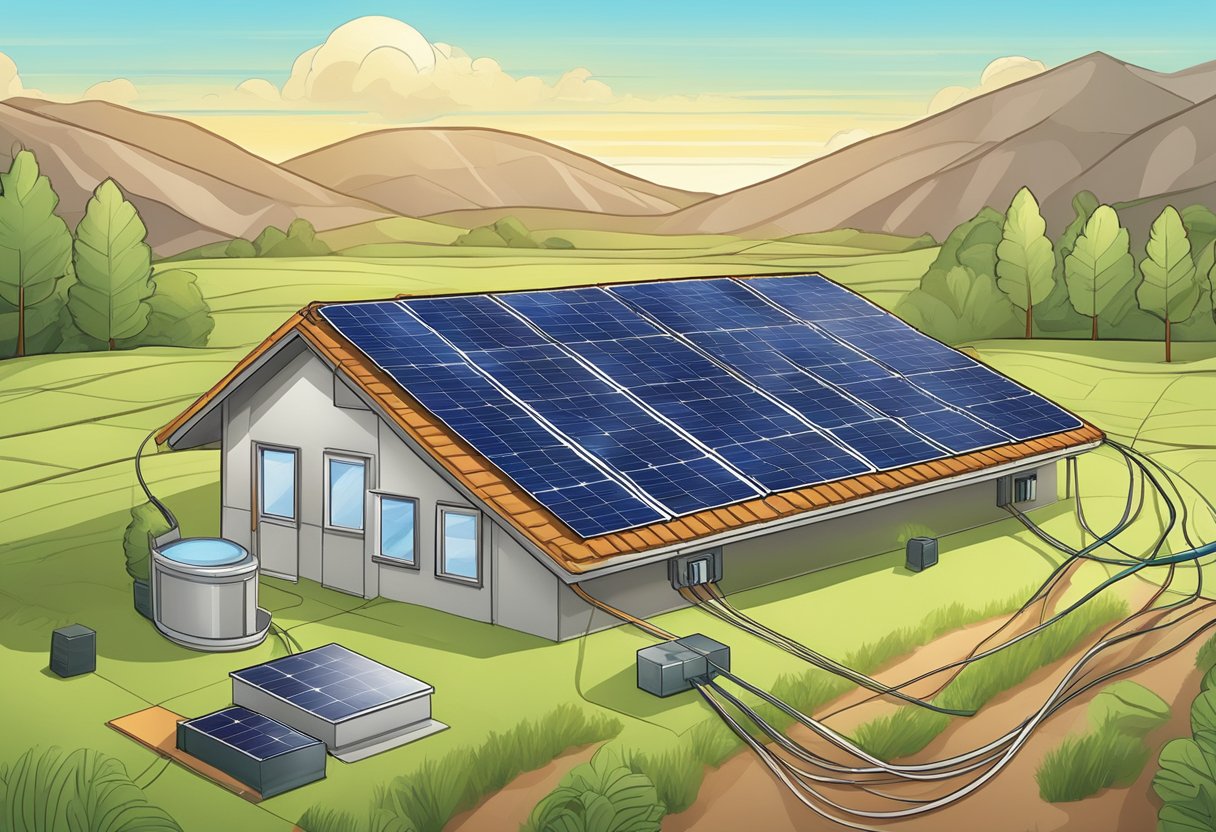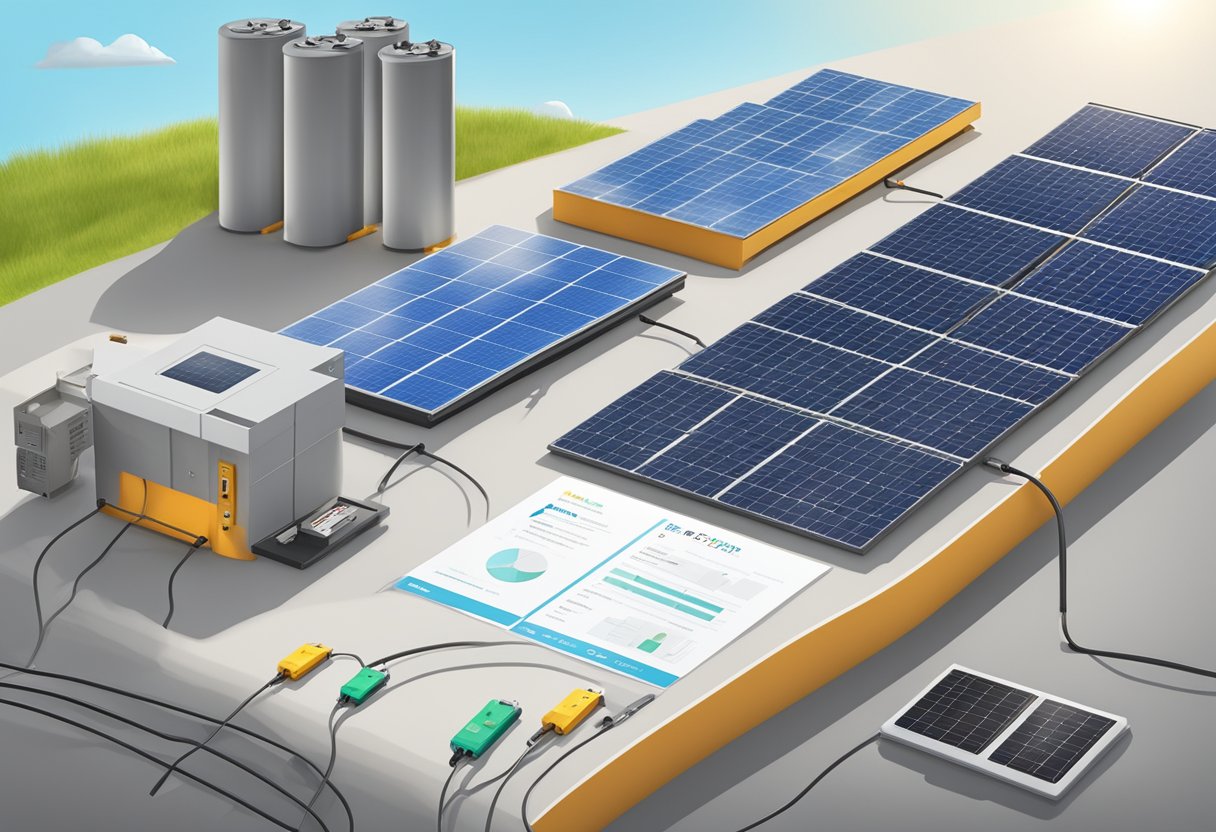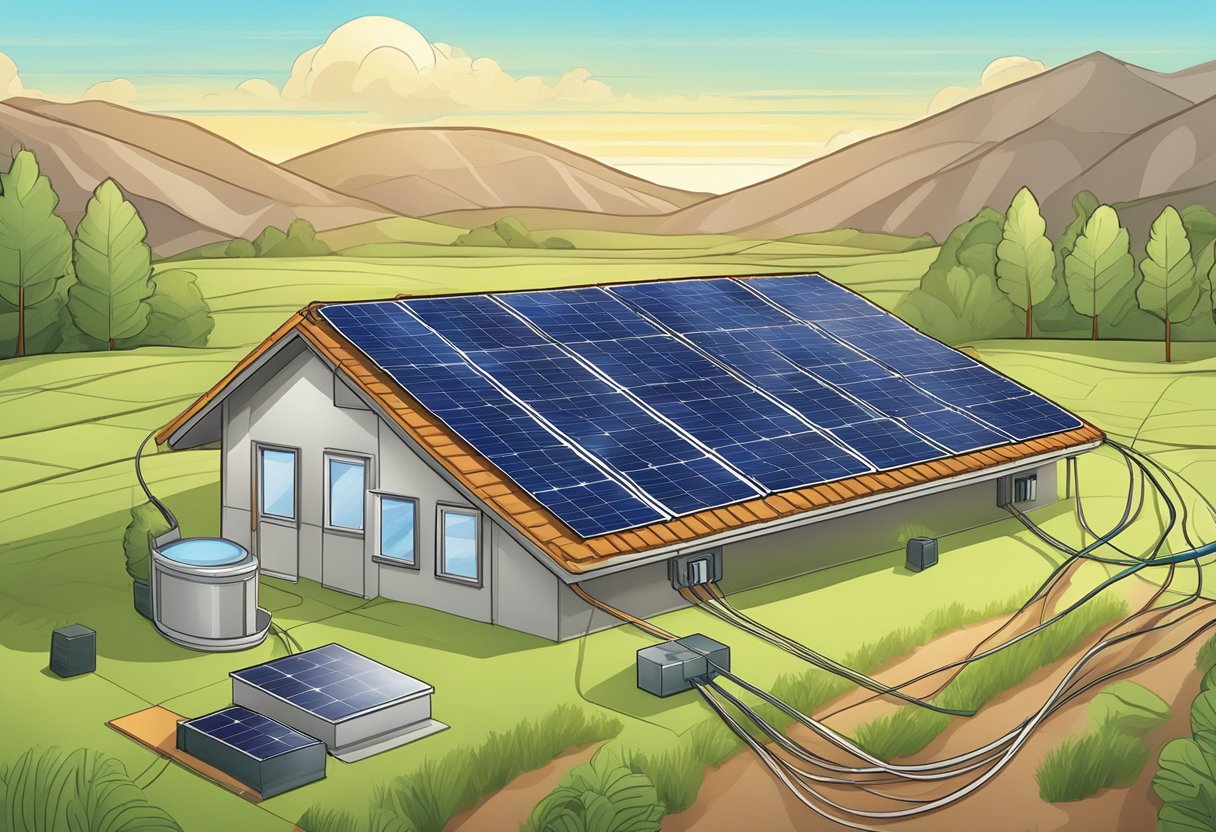LiFePO4 batteries are a popular choice for solar-powered systems due to their high energy density, long cycle life, and low risk of thermal runaway.
Solar charging LiFePO4 batteries is a cost-effective and eco-friendly way to keep them charged and ready to use.

To charge LiFePO4 batteries with solar panels, you need a solar charging system that includes a solar panel, a charge controller, and a battery.
The solar panel generates electricity from sunlight, which is then regulated by the charge controller to ensure that the battery is charged safely and efficiently.
When installing and configuring the solar charging setup, it is important to consider factors such as the size of the solar panel, the capacity of the battery, and the location of the system.
Proper maintenance and monitoring of the solar charging system can help ensure that it operates at peak efficiency and prolongs the life of the battery.
Key Takeaways
- LiFePO4 batteries are a popular choice for solar-powered systems due to their high energy density, long cycle life, and low risk of thermal runaway.
- To charge LiFePO4 batteries with solar panels, you need a solar charging system that includes a solar panel, a charge controller, and a battery.
- Proper maintenance and monitoring of the solar charging system can help ensure that it operates at peak efficiency and prolongs the life of the battery.
Understanding LiFePO4 Batteries and Solar Charging
Basics of LiFePO4 Battery Technology
LiFePO4 batteries, or lithium iron phosphate batteries, are a type of rechargeable battery that have gained popularity in recent years due to their high energy density and long cycle life.
These batteries are commonly used in applications such as electric vehicles, solar power systems, and portable electronics.
Compared to other types of lithium-ion batteries, LiFePO4 batteries are known for their safety and stability. They are less prone to overheating and have a lower risk of catching fire or exploding.
They also have a longer lifespan, with some LiFePO4 batteries lasting up to 10 years.
Solar Energy Fundamentals
Solar energy is a renewable energy source that is becoming increasingly popular as a clean and environmentally friendly alternative to traditional fossil fuels.
Solar panels are used to capture the energy from the sun and convert it into electricity that can be used to power homes, businesses, and other applications.
When it comes to solar charging, it is important to understand the basics of solar energy and how it works.
Solar panels are made up of photovoltaic cells that convert sunlight into direct current (DC) electricity. This electricity is then converted into alternating current (AC) electricity using an inverter, which can be used to power appliances and other devices.
Compatibility of Solar Panels with LiFePO4 Batteries
When charging LiFePO4 batteries with solar panels, it is important to ensure that the solar components are compatible with the battery technology.
One important factor to consider is the voltage and current rating of the solar panels and charge controller.
For example, a 12V LiFePO4 battery would require a solar panel that can output at least 14.4 volts to fully charge the battery.
It is also important to consider the capacity of the battery, with larger batteries requiring more solar panels and longer charging times.
Components of a Solar Charging System
When it comes to charging LiFePO4 batteries with solar power, having the right components is crucial. Below are the three main components of a solar charging system for LiFePO4 batteries:
Charge Controllers and Their Role
A charge controller is an essential component of a solar charging system. It regulates the amount of energy that flows from the solar panels to the battery, preventing overcharging and undercharging.
There are two types of charge controllers: MPPT (Maximum Power Point Tracking) and PWM (Pulse Width Modulation).
MPPT charge controllers are more efficient than PWM charge controllers, especially in low-light conditions. Therefore, it is recommended to use an MPPT charge controller when charging LiFePO4 batteries with solar power.
Selecting the Right Solar Panels
The solar panel size required for a solar charging setup depends on the battery type and capacity.
For LiFePO4 batteries, a 50 to 100 watt solar panel is recommended, with a maximum solar panel size of 120 watts.
It is important to select high-quality solar panels with a high conversion efficiency to ensure optimal charging performance.
Battery Management Systems (BMS)
A battery management system (BMS) is responsible for monitoring the battery’s state of charge (SOC) and ensuring that it is charged and discharged safely.
It also protects the battery from overcharging, over-discharging, and overheating.
It is recommended to use a BMS specifically designed for LiFePO4 batteries when charging them with solar power.
When setting up a solar charging system, make sure to follow safety best practices and use the appropriate components, such as solar adapter cables, battery cables, fuses, fuse holders, switches, and wiring diagrams.
It is also recommended to consult a professional or a DIY solar power system guide to ensure that the solar charging system is set up correctly and safely.
Installing and Configuring the Solar Charging Setup
Step-by-Step Installation Guide
To install and configure a solar charging setup for LiFePO4 batteries, follow these steps:
- Choose a suitable location for your solar panel where it can receive maximum sunlight. Consider factors such as shade, tilt angle, and positioning.
- Connect the MC4 to SAE adapter cable to your solar panel and the Allto Solar MPPT charge controller.
- Connect the SAE to battery alligator clips to the charge controller.
- Connect the LiFePO4 battery to the charge controller using the SAE extension cable.
- Install a fuse holder between the battery and charge controller for safety purposes.
- Refer to the wiring diagram provided with your solar panel kit to ensure correct wiring.
Optimizing Panel Efficiency and Placement
To optimize the efficiency of your solar panel, consider the following factors:
- Tilt angle: Adjust the tilt angle of your solar panel to match your latitude. This will ensure maximum sunlight exposure.
- Positioning: Place your solar panel in a location where it can receive maximum sunlight. Avoid shading from trees or buildings.
- Temperature compensation: Some charge controllers offer temperature compensation to adjust the voltage output based on the temperature. This can improve the efficiency of your solar panel.
Wiring and Safety Precautions
When wiring your solar charging setup, make sure to follow these safety guidelines:
- Use solar adapter cables to ensure compatibility between components.
- Install a fuse holder between the battery and charge controller to prevent overcurrent or short circuits.
- Use AGM or sealed lead-acid batteries for safety and stability.
- Consider the depth of discharge and voltage limits of your battery to prevent damage.
- Avoid extreme temperatures that can affect the charging profile and durability of your battery.
Maintaining and Monitoring Your Solar Charging System
Regular Maintenance for Longevity
To ensure that your LiFePO4 battery lasts for as long as possible, it’s important to perform regular maintenance on your solar charging system. This includes cleaning the solar panels, checking the battery voltage, and inspecting the battery management system.
Cleaning the solar panels is essential for maintaining the charging efficiency of your system.
Dirt, dust, and debris can build up on the surface of the panels, reducing their ability to absorb sunlight. Regular cleaning with a soft cloth and mild detergent can help to keep your panels in top condition.
Checking the battery voltage is also important for maintaining the longevity of your battery.
Overcharging can cause damage to the battery, shortening its cycle life and reducing its efficiency. By monitoring the battery voltage regularly, you can ensure that it is not being overcharged and that it is operating within a safe range.
Inspecting the battery management system is another important step in maintaining your solar charging system.
The battery management system helps to regulate the charging process, ensuring that the battery is charged at the correct rate and that it is not being overcharged. Regular inspections can help to identify any issues with the system, allowing you to address them before they cause damage to the battery.
Monitoring Systems and Performance Tracking
In addition to regular maintenance, it’s also important to monitor the performance of your solar charging system. This can help you to identify any issues with the system and to track its efficiency over time.
One key metric to track is the charging efficiency of the system.
This refers to the percentage of energy from the solar panels that is actually being used to charge the battery. By tracking the charging efficiency over time, you can identify any issues with the system and make adjustments as needed to improve its performance.
Another important metric to track is the cycle life of the battery.
The cycle life refers to the number of times that the battery can be charged and discharged before it begins to lose capacity. By monitoring the cycle life of the battery, you can ensure that it is being used properly and that it is not being overcharged or discharged too quickly.
Advanced Considerations and Troubleshooting
Expanding Your Solar System
If you plan to expand your solar system, it’s important to consider the compatibility of your components.
When adding more solar panels to your system, make sure that your charge controller is rated to handle the additional power.
Additionally, if you plan to connect multiple batteries in parallel or series, make sure that they are of the same type and capacity.
It’s also important to consider the size of your solar array.
If your solar panels are too small, you may not be able to generate enough power to fully charge your batteries. On the other hand, if your solar panels are too large, you may risk overcharging your batteries, which can be dangerous.
Troubleshooting Common Issues
When setting up a solar charging system for your LiFePO4 batteries, it’s important to take precautions to ensure safety and efficiency.
One common issue that can arise is a malfunctioning charge controller. If your batteries are not charging properly, it may be due to a faulty charge controller.
Another issue that can occur is a mismatch between your solar panel and battery capacity.
If your solar panel is too small for your battery, it may take longer to charge, or it may not fully charge at all. Conversely, if your solar panel is too large for your battery, it may risk overcharging and damaging the battery.
To avoid these issues, it’s important to monitor your system regularly and make adjustments as needed.
You may also want to consider investing in a battery management system (BMS) to help regulate the charging profile of your batteries.
Frequently Asked Questions

What are the optimal charge controller settings for LiFePO4 batteries when using solar panels?
The optimal charge controller settings for LiFePO4 batteries when using solar panels are dependent on the specific requirements of your battery.
Generally, a charging voltage of around 14.4 to 14.6 volts for a 12V battery is recommended. The charging current should typically be set at 0.5C, where C is the battery’s capacity in amp-hours.
Some charge controllers offer presets for different battery types. If your controller has a LiFePO4 preset, use it as a starting point, but adjust the settings based on your battery manufacturer’s specifications.
How do you size a solar panel system for charging a 100Ah LiFePO4 battery?
To size a solar panel system for charging a 100Ah LiFePO4 battery, you need to consider the battery’s charging requirements and the amount of sunlight available in your location.
A 100W 12V solar panel is recommended for this setup, but you could use a smaller or bigger one as long as it’s still a 12V panel. The maximum solar panel size for this setup is 120 watts.
What is the recommended voltage for charging LiFePO4 batteries with a solar setup?
The recommended voltage for charging LiFePO4 batteries with a solar setup is around 14.4 to 14.6 volts for a 12V battery. However, it’s essential to check your battery manufacturer’s specifications for the optimal charging voltage.
Can a lithium iron phosphate (LiFePO4) battery be charged directly from a solar panel without a charge controller?
No, a lithium iron phosphate (LiFePO4) battery should not be charged directly from a solar panel without a charge controller.
A charge controller is essential to regulate the charging voltage and current to prevent overcharging, which can damage the battery.
What are the advantages of using an MPPT solar charge controller with LiFePO4 batteries?
An MPPT solar charge controller is more efficient than a PWM controller, especially when charging LiFePO4 batteries.
MPPT controllers can convert excess voltage into additional current, which can result in up to 30% more power production than PWM controllers. Additionally, MPPT controllers can adjust the charging voltage and current to match the battery’s requirements, resulting in faster and more efficient charging.
How do you determine the best solar charge controller for a LiFePO4 battery system?
To determine the best solar charge controller for a LiFePO4 battery system, you need to consider the battery’s charging requirements, the solar panel’s wattage and voltage, and the controller’s features.
Look for a controller that has a LiFePO4 preset or allows you to customize the charging voltage and current. Additionally, consider an MPPT controller for more efficient charging.



